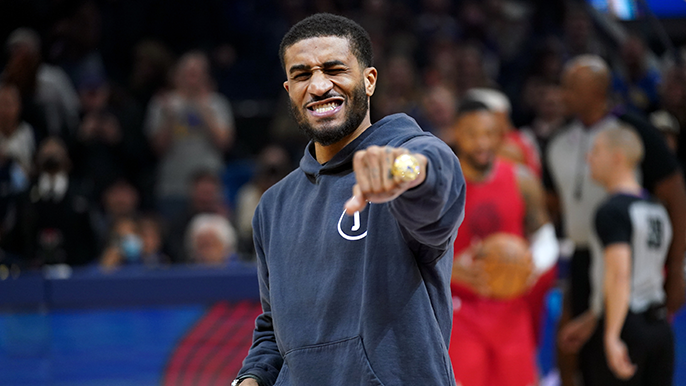
Warriors general manager Bob Myers took the long route to bring Gary Payton II back. In a trade deadline defined by the Suns taking one of the biggest swings in NBA history by landing Kevin Durant, Myers’ maneuvering reinforced the Warriors’ bench and made them a more formidable contender than they were yesterday.
It wasn’t a straight-up swap, but in simple terms, the Warriors sent out former No. 2 pick James Wiseman to bring in Gary Payton II.
Along with adding a championship-proven player who has familiarity with the Warriors’ ecosystem, the Warriors also worked toward alleviating their ginormous looming luxury tax bill.
Here’s how they did it, and what it means.
The Wiseman trade
It was initially reported that Golden State would be getting Pistons wing Saddiq Bey in return for Wiseman. But eventually, the Atlanta Hawks emerged as a third team in the trade and became Bey’s new home.
The trade essentially served as a table-setting move for the Warriors to reel in Portland.
The details:
Warriors receive: Five second round picks (from Atlanta), Kevin Knox (from Detroit)
Pistons receive: James Wiseman
Hawks receive: Saddiq Bey
The best player in the deal, undoubtedly, is Saddiq Bey. The Villanova product was a First-Team All-Rookie selection in 2021 and is a career 35.7% 3-point shooter. He’s had significantly more success than Wiseman and Knox since getting drafted.
But Wiseman remains the highest-ceiling player among the trio. In Detroit, the seven-footer should get the opportunities to learn the game and develop that weren’t available with the perennially contending Warriors.
The Payton trade
Five second-round picks don’t do much to help the Warriors’ pursuit of a fifth NBA championship in the Stephen Curry era.
So, they flipped them.
Golden State redirected Knox and the five second-rounders they received from Atlanta to Portland in exchange for Payton II.
The move comes just hours after Payton matched up with his former team, scoring nine points in a 125-122 Blazers victory. After the game, he and Jordan Poole swapped jerseys.
It’s unclear why Portland would want to give up on Payton after just 15 games played. He hasn’t had the same impact as he did with the Warriors, but the return for the defensive-minded guard seems low.
Portland also traded two-way wing Josh Hart before the deadline, creating more playing time for rookie Shaedon Sharpe. But losing Hart and Payton II weakens the Blazers’ defense and perhaps signals they’re intent on taking a step back this season.
Salary cap implications
With all the dizzying moves, the Warriors appear to have saved a total of $37 million because Wiseman is set to make more than Payton, and the Warriors are well over the tax as repeat payers, any salary shedding can go a long way.
Payton’s three-year, $26 million deal means he makes an average of $8.7 million through the 2024-25 season (which is a player option for him). That’s much less than Wiseman’s rookie-scale deal, which owes him $9.6 million this year and $12.1 million next season.
If the Warriors retain all their veterans, their payroll next year could approach half a billion dollars. Owner Joe Lacob, who is already paying a record tax bill, has publicly indicated he isn’t comfortable with that gargantuan number.
Shedding some salary by swapping Wiseman for Payton could make next year’s payroll slightly more manageable.
How Payton fits
On paper, the Warriors are selling low on their former No. 2 pick. But Payton is a clear upgrade over Wiseman, who was out of the rotation, for the immediate term. And if Payton helps the Warriors defend their title, admitting his sunk cost would be worth it.
On the court, Payton has already proven he can provide value for the Warriors. Golden State’s defense ranks 18th in efficiency this year — nowhere close to championship-caliber. Payton immediately helps that.
As an on-ball defender, Payton can lock down point guards and shooting guards. He’s active on both the offensive and defensive glass and can be dangerous as a weak-side helper. Although Payton is 6-foot-3, he competes against players much taller than him, making him useful in small-ball lineups.
With Payton, the Warriors are significantly more multiple. They can run out defensive-minded lineups including a combination of Payton, Donte DiVincenzo, Andrew Wiggins, Jonathan Kuminga and Draymond Green. That specific five wouldn’t have enough shooting, but Steve Kerr will be able to choose from at least three of those — depending on matchup and who’s shooting well — to complement Golden State’s premium scorers.
Just how valuable is Payton’s skill set? Last year, three of Golden State’s four most successful lineups featured him.

